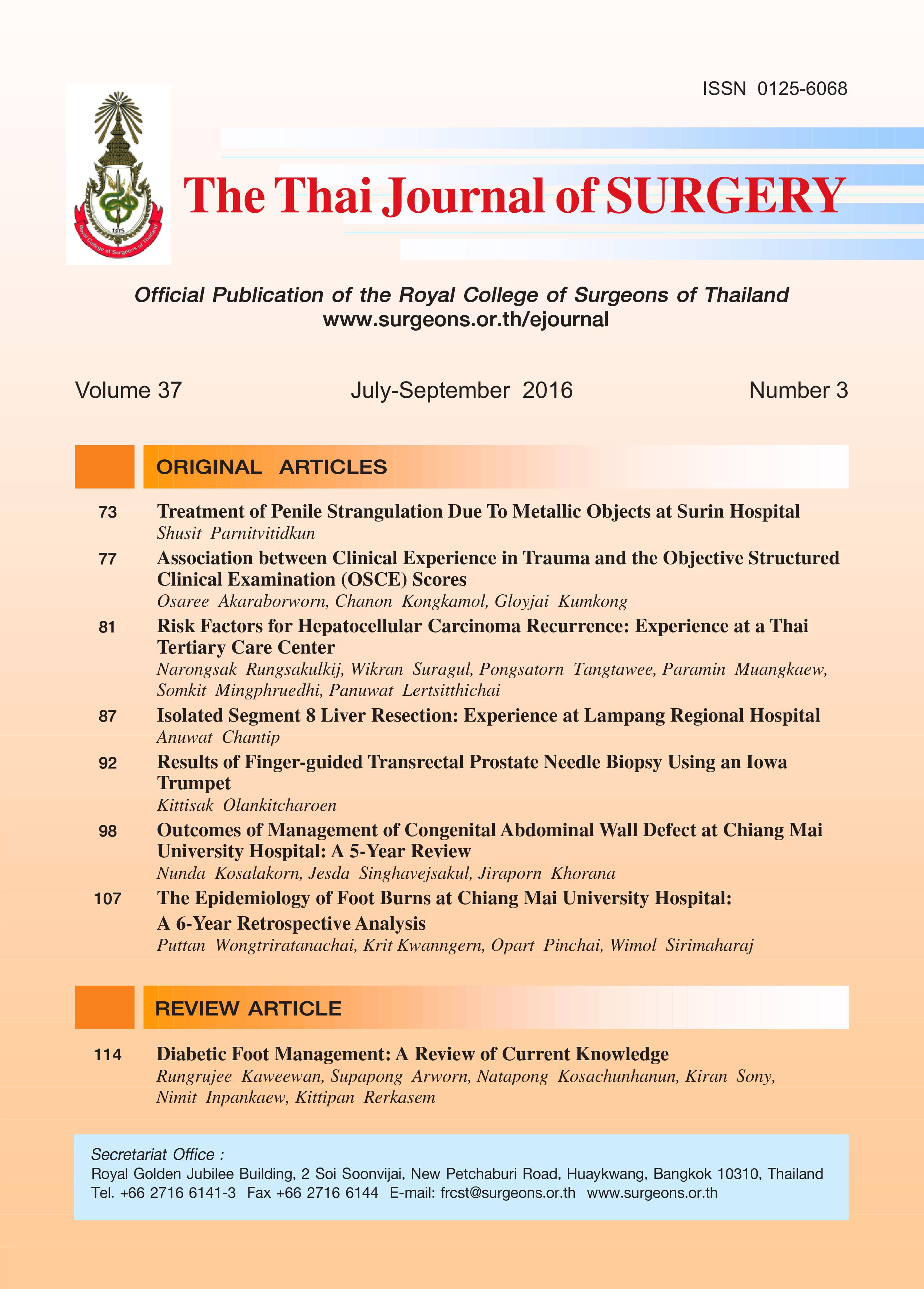Outcomes of Management of Congenital Abdominal Wall Defect at Chiang Mai University Hospital: A 5-Year Review
Keywords:
Gastroschisis, omphalocele, abdominal wall defectAbstract
Background: Omphalocele and gastroschisis are the two most common congenital malformations of theabdominal wall. The goal of surgery is to accomplish abdominal wall closure in a single stage, although a number of
options exist when this is not possible.
Method: A retrospective study of patients with gastroschisis and omphalocele treated at Chiang Mai University
Hospital between January 2006 and September 2011 was performed. Perinatal data and long term outcomes were
collected.
Result: Medical records of 95 infants with gastroschisis and 23 infants with omphalocele were reviewed.
Prenatal diagnosis was made in 42/95 infants (44%) in the gastroschisis group, and 15/23 infants (65%) in the
omphalocele group. Associated anomalies were seen in 26/95 infants (27%) in the gastroschisis and in 18/23 infants
(78%) in the omphalocele groups. In infants with gastroschisis, primary fascial closure could be performed in 65/
95 (68%), with the advantages of a short-duration total parenteral nutrition, shorter hospital stay, and lower
complication rates. In infants with omphalocele, abdominal wall closure was done in 10/23 (43%), with the
advantages of shorter hospital stay and lower incidence of ventral hernia. The survival probability at 1 to 2 years was
92% in the gastroschisis and 87% in the omphalocele groups. Most of these infants had normal long term growth and
development.
Conclusion: Primary fascial closure can usually be achieved in gastroschisis, and to a lower extent, in
omphalocoele, with clear advantages. Long-term outcomes were favorable in most cases.
References
gastroschisis and associated malformations. Am J Med
Genetics Part A. 2008;146:1280-5.
2. Axt R, Quijano F, Boos R, Hendrik HJ, et al. Omphalocele and
gastroschisis: prenatal diagnosis and peripartal
management. A case analysis of the years 1989-1997 at the
Department of Obstetrics and Gynecology, University of
Homburg/Saar. Eur J Obstet Gynecol Repro Biol 1999;87:47-
54.
3. Klein MD. Congenital Defects of the Abdominal Wall. In:
Coran AG, Adzick NS, Krummel TM, Laberge J-M, Shamberger
RC, Caldamone AA, editors. Pediatric Surgery. 2. 7th ed.
Philadelphia: Saunders; 2012. p. 973-084.
4. Islam S. Congenital Abdominal Wall Defects. In: Holcomb
GW, Murphy JP, Ostlie DJ, editors. Ashcraft’s Pediatric Surgery.
1. 6th ed. London: Elsevier Saunders; 2014. p. 660-72.
5. Henrich K, Huemmer HP, Reingruber B, Weber PG.
Gastroschisis and omphalocele: treatments and long-term
outcomes. Ped Surg Int 2008;24:167-73.
6. Gamba P, Midrio P. Abdominal wall defects: prenatal
diagnosis, newborn management, and long-term outcomes.
Semin Ped Surg 2014;23:283-90.
7. Maramreddy H, Fisher J, Slim M, Lagamma EF, Parvez B.
Delivery of gastroschisis patients before 37 weeks of gestation
is associated with increased morbidities. J Ped Surg
2009;44:1360-6.
8. Barseghyan K, Aghajanian P, Miller DA. The prevalence of
preterm births in pregnancies complicated with fetal
gastroschisis. Arch Gynecol Obstet 2012;286:889-92.
9. Moir CR, Ramsey PS, Ogburn PL, Johnson RV, Ramin KD. A
prospective trial of elective preterm delivery for fetal
gastroschisis. Am J Perinatol 2004;21:289-94.
10. Hadidi A, Subotic U, Goeppl M, Waag KL. Early elective
cesarean delivery before 36 weeks vs late spontaneous
delivery in infants with gastroschisis. J Ped Surg 2008;43:1342-
6.
11. Nasr A, Wayne C, Bass J, Ryan G, Langer JC. Effect of
delivery approach on outcomes in fetuses with gastroschisis.
J Ped Surg 2013;48:2251-5.
12. Dunn JC, Fonkalsrud EW, Atkinson JB. The influence of
gestational age and mode of delivery on infants with
gastroschisis. J Ped Surg 1999;34:1393-5.
13. Logghe HL, Mason GC, Thornton JG, Stringer MD. A
randomized controlled trial of elective preterm delivery of
fetuses with gastroschisis. J Ped Surg 2005;40:1726-31.
14. Benjamin B, Wilson GN. Anomalies associated with
gastroschisis and omphalocele: analysis of 2825 cases from
the Texas Birth Defects Registry. J Ped Surg 2014;49:514-9.
Downloads
Published
How to Cite
Issue
Section
License
Articles must be contributed solely to The Thai Journal of Surgery and when published become the property of the Royal College of Surgeons of Thailand. The Royal College of Surgeons of Thailand reserves copyright on all published materials and such materials may not be reproduced in any form without the written permission.



